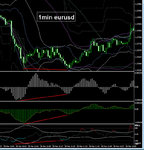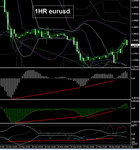bbmac
Veteren member
- Messages
- 3,584
- Likes
- 789
Re PA your 5min chart shows perfectly that on 1st test shown on that t/f there were buyers willing to transact there - price pulls back and on a 2nd slightly lower test on this t/f - buyers emerged again...no real divergence in the momentum oscillators (save for same valley div) on this 5min t/f but divergence present on 1min, 30min and 1hr - and on this 1hr t/f - double divergence in the osma - so on each consecutive swing lower on this 1hr t/f momentum was diminishing (potentially) - that was the indication...of course if acting on a sub 30min t/f pa trigger that bullish div on 30min and 1hr would not have been confirmed by pa on those t/f's - but it was 'potentially' there nonetheless.
I think it is about getting the highest degree of confluence re potential sup/res factors and other factors you may choose to use (like divergence etc) and see-ing if PA agrees with the working assumption that - in this eg - buyers may be present at such a potential sup zone...and if possible developing this into a rule set for your edge - if you trade this way.
G/L
I think it is about getting the highest degree of confluence re potential sup/res factors and other factors you may choose to use (like divergence etc) and see-ing if PA agrees with the working assumption that - in this eg - buyers may be present at such a potential sup zone...and if possible developing this into a rule set for your edge - if you trade this way.
G/L
Quite interesting that, bb. The first hit on the support zone seemed to have a lot of oomph behind it (on M5 too) so my money would have been on a break. Not to be and the second dip half an hour later had much less momentum behind it and seemed the better bet for a reversal even though it made a slightly lower low.
Be interested how you take account of momentum and how you judge it.


